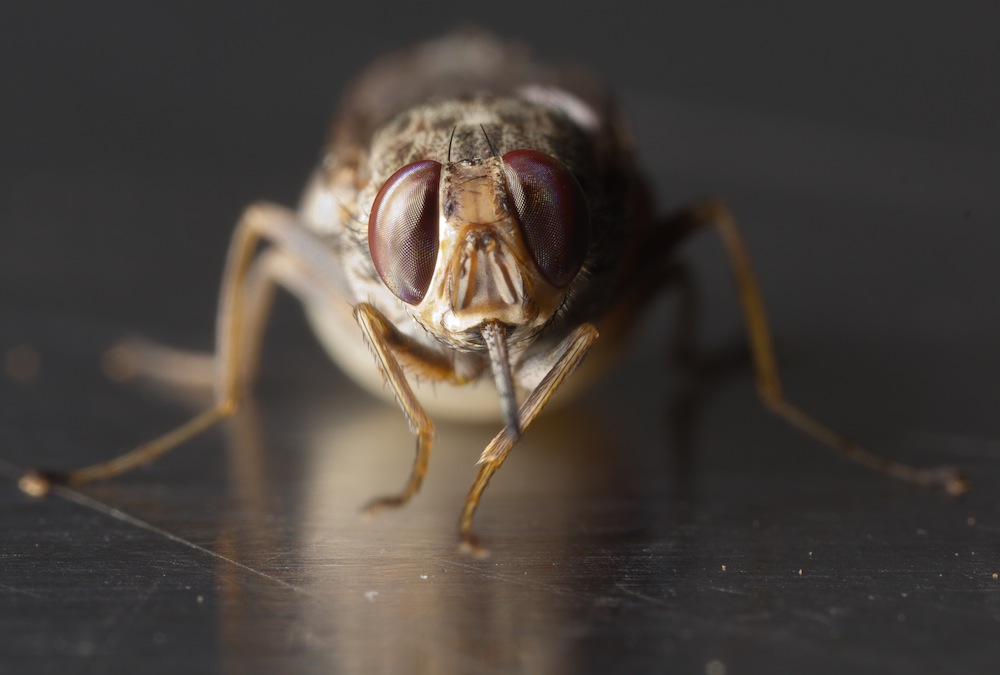To Fight Sleeping Sickness, Tsetse Fly Genome Decoded
Scientists have sequenced the full genome of the tsetse fly, the blood-sucking pest that spreads deadly sleeping sickness in sub-Saharan Africa.
The genome sequence gave scientists a peek at what makes the tsetse fly (Glossina morsitans morsitans) unusual, from salivary proteins that enable its blood-only diet to genes that enable it to give live birth and nurse its developing young.
"Our goal is to enhance the toolbox that will be available to scientists and communities who are under the pressure of dealing with this disease," lead researcher Serap Aksoy, an epidemiologist at Yale University, told Live Science. [Ick: Blood-Sucking Tsetse Flies Caught on Video]
Sleeping sickness

Sleeping sickness, or trypanosomiasis, is an infection by a single-celled organism called a protozoan. Symptoms begin with fever, itching and pain as the protozoa multiply in the body, according to the World Health Organization (WHO). When the protozoa, known as trypanosomes, enter the brain, symptoms advance to include confusion and disruptions in coordination. The disease also affects the sleep cycle, giving it its name. Without treatment, sleeping sickness is fatal.
Sleeping sickness (also called nagana when it affects cattle) tends to come in epidemics, the last of which occurred during the 1990s, Aksoy said. There is no vaccine, and treatment can be difficult, because the disease affects rural populations with little access to medical care.
In 2004, Aksoy and her colleagues founded the WHO-funded International Glossina Genome Initiative to map the full genetic sequence of the tsetse fly that spreads trypanosomes through its bites. A major goal, Aksoy said, was to bring together scientists from sub-Saharan Africa and train younger researchers to use the blueprint to fight the disease.
Sign up for the Live Science daily newsletter now
Get the world’s most fascinating discoveries delivered straight to your inbox.
Using multiple genetic methods, the team mapped the genome of the fly, announcing their success today (April 24) in the journal Science. Ten papers outlining some of the major genetic findings will also appear in the open-access journal PLOS Neglected Tropical Diseases.
Genetic weaknesses
The findings reveal several avenues that researchers could pursue in attempting to control the fly. Among the 12,308 protein-encoding genes in the tsetse genome are ones that provide the instructions to build the proteins in the fly saliva. Without these proteins, flies couldn't overcome blood clotting, for example, and so wouldn't be able to feed and survive, the researchers reported. Scientists could develop a vaccine against one or more of these proteins, which would prevent flies from feeding on humans or livestock, Aksoy said.
Or, she said, a vaccine could target the fly's gut proteins, perhaps doing so much damage to those proteins that the blood meals would kill the flies.
Man-made tsetse fly traps use blue-and-black coloration to attract the flies. Aksoy and her team found that flies could indeed see blue, explaining why these traps are effective. They also identified the genetics of the flies' sense of sight and smell, which could lead to the development of even more effective traps.
Tsetse flies are unusual in that both males and females eat only blood. However, blood lacks certain crucial nutrients, mostly vitamins, Aksoy said. The researchers investigated the flies' microbiome, or the beneficial bacteria that live in symbiosis with the flies. They found bacteria crucial to producing nutrients such as B vitamins and thiamine. Wiping out these bacteria could prevent flies from reproducing.
The flies are also vulnerable to death because of their weird mammalian style of giving birth, Aksoy said. Females have one baby at a time, and give birth to live young. Unlike egg-laying insects, tsetse flies have perhaps 10 or so offspring in their lifetimes. And in the uterus, they nourish the developing young with secretions that are the insect version of mother's milk. The new genetic blueprint reveals the genes behind these processes, meaning they could be disrupted.
Aksoy and her colleagues now have funding from the National Institutes of Health to sequence the genomes of five other flies in the tsetse fly's family, as well as more distant relations such as the housefly. Comparing the flies should help explain why tsetse flies transmit deadly disease, while houseflies are harmless, Aksoy said.
Follow Stephanie Pappas on Twitter and Google+. Follow us @livescience, Facebook & Google+. Original article on Live Science.

Stephanie Pappas is a contributing writer for Live Science, covering topics ranging from geoscience to archaeology to the human brain and behavior. She was previously a senior writer for Live Science but is now a freelancer based in Denver, Colorado, and regularly contributes to Scientific American and The Monitor, the monthly magazine of the American Psychological Association. Stephanie received a bachelor's degree in psychology from the University of South Carolina and a graduate certificate in science communication from the University of California, Santa Cruz.









